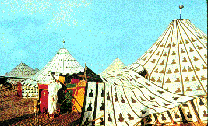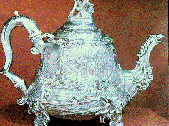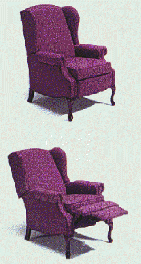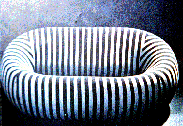

What follows is a set of criteria that can be used to make objective judgements about the success or failure of the visual components of functional design. These criteria will be in the form of a set of questions to be considered. This approach is intended to suggest a reasoned approach to the determination of success or failure of a design, not to establish an absolute test. Depending on the nature and purpose of the object, some factors considered will be of greater or lesser importance.
There are two ways this list of criteria could be used. The temptation might be to use these criteria to support a preconceived conclusion, based on personal preference. This is not the intended purpose of the criteria, however. Such a preconceived persuasive approach might be useful if the goal was simply to "sell" the item to a client, but it would not be an objective and fair approach to the evaluation of functional design. If we start from our own biases about a problem and fail to consider all possible factors, we may fail to reach the truth. For a more reasoned and balanced approach, which is our purpose, it is necessary to use these criteria to identify both the strengths and weaknesses of the object, and then reach a conclusion regarding the relative success or failure of the design, based on full analysis.
 Before
we look at these criteria, however, we need to clarify some terms. First, we
will be looking at objects from the point of view of function.
This means that the first thing we need to determine in each case is the real
intended purpose of the object. If we are not clear about the function, we will
not be able to make a sensible judgement. For example, if we are presented with
a bra made of plumbing fixtures and barbed wire, it is important to be clear
that its maker intended it as a work of art to be displayed in a gallery, a
metaphor that expresses her views about the female body and female roles. To
judge it as clothing is pointless, as clearly no one ever intended that this
"garment" be produced for actual wear.
Before
we look at these criteria, however, we need to clarify some terms. First, we
will be looking at objects from the point of view of function.
This means that the first thing we need to determine in each case is the real
intended purpose of the object. If we are not clear about the function, we will
not be able to make a sensible judgement. For example, if we are presented with
a bra made of plumbing fixtures and barbed wire, it is important to be clear
that its maker intended it as a work of art to be displayed in a gallery, a
metaphor that expresses her views about the female body and female roles. To
judge it as clothing is pointless, as clearly no one ever intended that this
"garment" be produced for actual wear.
Incidentally, to say that an object is functional simply means that it has a practical use. The question is whether it performs that function satisfactorily! So if you wish to say that the object does its job well, you must say that it functions well (or whatever descriptor fits).
That having been established, however, we will then be considering the visual aspects of the design in relation to its function. Visual design may be considered in structural, or applied decorative terms.
Structural design can be found in any made object. It is the essential form of the object, its framework. It defines the object in space
Applied decorative design is not strictly essential to the existence of the object, though it may affect its successful functioning. It is the surface embellishment of the structural form. Applied decorative design can be removed from the object and you still have the object, and it will still perform its function. You can't remove structural design from the object, on the other hand, since that is its basic form; you would no longer have an object, much less a function.
Applied decorative design can be classified as naturalistic; that is, intended to be a true and realistic representation of the subject. Or, it may be stylized. Stylized designs are caricatures of reality, presenting us with an identifiable image of, say, a cat, or a flower, or a man; but in a kind of visual shorthand that provides essential cues, but not enough to be seen as a true-to-life, individualized portrait.
Geometric designs do not provide recognizable representations, but instead offer decorative designs based on regular lines, angles, and curves like those in measured geometric forms. Organic/nonobjective designs also lack recognizable subject matter, but use irregular and/or asymmetrical lines and forms.
We are now going to look at some criteria for evaluating structural and applied decorative design. Remember, it is not necessary for an item to elicit a positive answer on every item in order to have it be judged a successful design. In fact, it is conceivable an item might be judged unfavorably on most of the criteria, providing it is judged favorably on the criteria most important to its function. Function, then, is the primary yardstick by which the importance of other criteria should be measured. So the first question to decide is what is the intended function of the object?
Some of these criteria apply only to structural design, some to applied decorative design, others to both. We will begin with those that relate to structural design.
1. FORM/FUNCTION Does form follow function? Is the form or shape suitable to the intended purpose of the object?

These stackable chairs, commonly seen in classrooms all over campus, are a successful combination of form and function. The Fiberglass form is contoured to fit most bodies, and the form also permits stacking, which allows the room to be cleared of chairs when they are not needed.
<
2. APPROPRIATENESS OF MATERIALS Does the material used suit the
function? Are the materials used appropriate and practical for the
purpose?

Correct choice of materials is always an important decision for designers of clothing. Issey Miyake's distinctive designs always take advantage of the characteristics of the fabric; in this coat, the way that the stiff material falls in folds is incorporated into the design; another, softer, material would not create the silhouette he intended.
3. HONEST USE OF MATERIALS (A two part question:)
Next we will look at some criteria that consider applied decorative design:
4. PURPOSE What is the purpose of the applied decorative design? Is it necessary? Does it enhance the object's function?
5. CONCEPT Is the applied decorative design harmonious in design and
idea with the purpose of the object?

The purpose of this object is to serve as a telephone. The decorative design and form are that of an iron. The intention is obviously to be humorous, and although we may laugh when we look at this, it is unlikely that many will wish to own and use such a telephone on a permanent basis-the incongruence of design, purpose, and idea is too great.
6. SPATIAL PLACEMENT Is the design ordered to relate to the space on
which it is placed?

This Moroccan wedding tent is a beautiful example of decorative design that has been planned for the form of the object.
7. STRUCTURAL COHERENCE of decorative design and form: Does the
decorative design reinforce, or hide the structure?

The decorative design applied to this teapot was intended to memorialize the Boston Tea Party. Although beautifully crafted and historically significant, the decoration does ignore, distort and hide the form of the teapot, making it less practical for its other function of serving tea.
The final set of questions applies to BOTH structural and applied
decorative design:
8. AESTHETICS Is the form and decoration well executed in terms of style, skill, and craftsmanship?

This beautiful Japanese box was first woven of wicker in a complex pattern, then lacquered and decorated with painted fish. Skill and craftsmanship have produced a beautiful composition that surely enhances the box.
9.TELESIS (a term suggested by Victor Papanek in Design for the Real World ) -Again, a two-part question:

10. INNOVATION Is the design a new expression, or merely a superficial change? Does it have individuality, or is it a cliche?

This chair was designed in 1899, and it was a new idea in its day. The fact that it has a look that would also comfortably fit into a contemporary room tells us that the design was not a superficial change.
11. LONGEVITY Has the form and design an appeal that can be sustained
during the length of time the object will be used? Is it destined to be a fad or a classic?

This inflatable sofa with its boldly striped design was a product of the late 60s and early 70s when there was interest in designing portable, even temporary, furniture that was suited to a young population that moved frequently. This idea of throwaway furniture was a short-lived fad, since people who move a lot actually found that they like to bring familiar objects with them to establish their own personal sense of a home. Also, the idea of disposable furniture became ecologically unacceptable to many.
Normally furniture is perceived as a major, long-term investment. Therefore choosing a sofa with a strong design would be not recommended, since the pattern and shape would likely go out of style before the sofa wore out. However, this relatively inexpensive inflatable sofa was not intended to last long. So if the customer wanted to make a strong statement with this piece of furniture, no reason not to. By the time he/she became tired of it, the sofa would develop a leak and be in the trash can. So the appeal will last about the same length of time as the sofa.
If you would like to see other examples of problems with design, try this link to a site on bad human factors design .

|